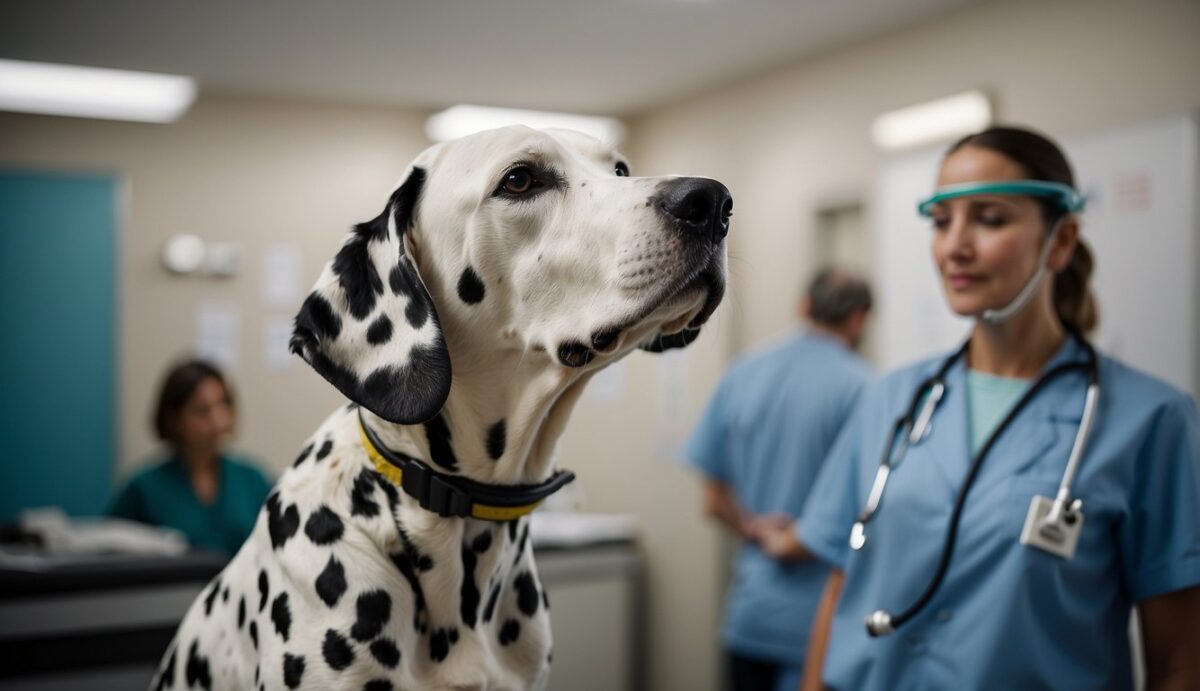Dalmatians are instantly recognized for their unique, spotted coats, but there is a less visible aspect of their heritage that concerns many who love the breed—deafness. This genetic predisposition is linked to the very genes that give them their distinctive markings.
Up to 30% of Dalmatians experience some form of hearing loss, and about 5% are deaf in both ears. The risk of injury increases for affected dogs, especially if they cannot hear dangers, such as oncoming traffic.
Understanding and managing this condition is crucial for the well-being of Dalmatians.
Early detection through hearing tests like BAER (Brainstem Auditory Evoked Response) can help in making informed decisions about care and breeding.
Breeding strategies have evolved to decrease the incidence of deafness, with responsible breeders conducting health screenings to ensure that both sire and dam are BAER tested with favorable results.
Key Takeaways
- Deafness in Dalmatians is often related to the genes responsible for their white coats.
- BAER testing is an essential tool for early detection of hearing impairment in the breed.
- Responsible breeding practices aim to reduce the occurrence of deafness in Dalmatians.
Understanding Deafness in Dalmatians

In this section, you’ll learn about the prevalence of deafness among Dalmatian dogs, the difference between bilateral and unilateral deafness, and the specifics of sensorineural deafness that affects canines.
Prevalence of Deafness in Dalmatians
Dalmatians are more susceptible to deafness than many other dog breeds. Studies estimate that 15% to 30% of Dalmatian dogs are affected by some degree of hearing loss. This condition may impact either one ear (unilateral) or both ears (bilateral).
Bilateral and Unilateral Deafness
- Bilateral Deafness: A Dalmatian with bilateral deafness cannot hear in either ear. This condition is less common but more challenging for the dog, as it heavily impacts their overall sensory perception.
- Unilateral Deafness: When a Dalmatian is unilaterally deaf, it means that they have lost hearing in one ear while the other ear functions normally. This condition can often go unnoticed by owners, as dogs can adapt to use their functioning ear.
Sensorineural Deafness in Canines
Sensorineural deafness is the result of a loss of function in the sensory hair cells of the inner ear or the nerves which send sound signals to the brain. In Dalmatians, this form of deafness is typically inherited and linked to the genes that give them their distinctive coat patterns.
Sensorineural deafness is a permanent type of hearing loss that currently cannot be cured.
Genetic Factors of Dalmatian Deafness

In understanding why Dalmatians are often affected by deafness, it’s crucial to look at the genetic factors that contribute to this condition. Your awareness of these factors is vital in the management and prevention of deafness.
Genes Influencing Deafness
The MITF (microphthalmia-associated transcription factor) gene plays a significant role in the development of congenital sensorineural deafness (CSD) in Dalmatians. This gene regulates the development of melanocytes, which are cells involved in pigmentation.
A link has been found between certain variants of the MITF gene and the prevalence of deafness.
Heritability of Deafness in Dogs
Deafness in Dalmatians is considered highly heritable, which means it’s an inherited condition. Research has shown that Dalmatians can pass the deafness trait to their offspring genetically.
As such, genetic tests are being developed to identify these traits, enabling breeders to make informed decisions.
The Role of Pigmentation in Deafness
The extreme piebald gene, associated with the Dalmatian’s distinctive white coat and spots, is linked to deafness. The lack of pigmentation associated with this gene can correlate with the absence of inner ear melanocytes, leading to your dog’s increased risk for deafness.
This relationship emphasizes the importance of genetic correlations and phenotypic expression in the genotype of the breed.
Diagnosing Deafness in Dalmatians

To accurately determine your Dalmatian’s hearing abilities, specialized testing, such as the BAER test, is employed. Understanding and interpreting the results of this test are key in managing hearing health.
The BAER Test
The Brainstem Auditory Evoked Response (BAER) Test is a reliable method used to evaluate the hearing of your Dalmatian. This non-invasive test measures the electrical activity in the brain in response to sound stimuli.
It’s important for you to know that:
- The test can be performed on puppies as young as six weeks old.
- Sedation is typically not required, making it safe for your dog.
During the BAER test, small electrodes are placed on your dog’s head and near the ears. Clicking sounds are played, and the response from your dog’s auditory pathways is recorded. The procedure typically takes around 15 minutes.
Interpreting BAER Test Results
After your Dalmatian undergoes a BAER test, the results will show the hearing status in both ears. Here’s what to expect:
- A normal hearing response will show clear waveforms on the test readout.
- Hearing loss may be unilateral (in one ear) or bilateral (in both ears), indicated by the absence of or irregular waveforms.
It’s crucial to have a BAER test done by a qualified veterinarian or veterinary neurologist who can accurately interpret the results. If any hearing loss is detected, they can guide you on how to manage a hearing-impaired dog and discuss further genetic testing and breeding considerations to prevent the propagation of hereditary deafness.
Prevention and Management Strategies

By implementing careful breeding considerations and ensuring early diagnosis and interventions, you can significantly influence the welfare of Dalmatians prone to deafness. As a responsible owner or breeder, knowing how to manage deafness in Dalmatians can improve the quality of life for these spotted companions.
Breeding Considerations
Responsible breeding practices are paramount in reducing the incidence of congenital deafness within the Dalmatian breed. When selecting mating pairs, breeders should prioritize genetic health and utilize BAER (Brainstem Auditory Evoked Response) testing to identify hearing impairments:
- BAER Testing: Ensure all breeding stock undergoes BAER testing. Breed only those Dalmatians that have bilateral hearing.
- Genetic Diversity: Aim for genetic diversity to reduce the chances of inheriting deafness-related genes.
- Record-Keeping: Maintain accurate records of hearing test results of all offspring to inform future breeding decisions.
Early Diagnosis and Interventions
Identifying deafness early in a Dalmatian’s life allows for immediate intervention that can help with their development:
- BAER Testing for Puppies: Have puppies tested for hearing at about six weeks of age.
- Environmental Influences: Minimize noise exposure to protect the auditory system during critical developmental periods.
- Exercise and Training: Introduce vibration toys and other sensory-stimulating activities to compensate for the loss of hearing.
Management of Deafness in Dalmatians
Caring for a deaf dog requires special attention to ensure they lead a full, happy life:
- Safe Environment: Create a safe home environment where the dog cannot easily escape or put themselves in danger, like unsupervised access to roads.
- Training: Use hand signals and visual cues to train your deaf Dalmatian, establishing effective communication.
- Regular Check-ups: Scheduled visits to the veterinarian can help monitor any related health issues and provide advice for ongoing care.
Living with a Deaf Dalmatian

Welcoming a deaf Dalmatian into your home means adapting your training methods and environment to suit their needs. Such adaptations are not only beneficial but also foster a strong bond of companionship and loyalty between you and your pet.
Training and Communication
Training a deaf Dalmatian requires a shift from auditory commands to visual cues. Begin by developing a set of hand signals for basic commands like sit, stay, come, and down.
Your Dalmatian’s keen visual awareness means they can learn to respond to these signals as effectively as they would to sound.
- Vibrations: You can get your Dalmatian’s attention by stomping on the ground or tapping them gently if they are not looking at you. The sensation of vibrations is an excellent way to communicate with your pet.
Make sure that every family member uses the same signals to avoid confusing your dog.
Safety and Environment Adaptations
It’s vital to maintain a safe and secure environment for your deaf Dalmatian. Since they can’t hear approaching traffic or other dangers, a well-fenced yard is important to prevent accidents.
Always keep your deaf Dalmatian on a leash during walks. This precaution keeps them safe from hazards they can’t hear like cars and bicycles.
Broader Implications and Considerations

In this section, you’ll explore how the deafness prevalent in Dalmatians extends beyond the individual dogs and significantly impacts both their welfare and the humans who care for them.
Welfare and Ethical Responsibilities
Your role as a Dalmatian owner or breeder carries a weighty ethical responsibility. Research indicates that deafness in Dalmatians has a genetic component. This means careful breeding practices can mitigate the condition to some extent. Moreover, organizations like the Animal Health Trust have contributed to the decline in deafness prevalence through collaborative studies.
As someone involved with these dogs, you’ll want to prioritize their welfare. This includes ensuring they live a life free from the trauma that can result from their condition, such as increased anxiety or accidents.
Understanding the Impact on Owners and Pets
The bond between you and your Dalmatian is unique, and the presence of deafness can introduce certain challenges. These may include:
- Communicative barriers: Affecting the ease of training and your day-to-day interactions.
- Increased vigilance: You must ensure a safe environment to prevent injury to a deaf dog that cannot hear dangers.
- Emotional impact: Deaf dogs often require more patience and understanding, which can affect the owner’s experience.
Dealing with a deaf dog can also influence how they’re portrayed in media, reshaping public perception when it comes to the responsibilities of owning a Dalmatian. Your experience and advocacy could help inform potential Dalmatian owners to make well-informed decisions fostering better companionship and care.
Preventing Infections and Promoting Wellness
In addition to managing deafness, Dalmatian owners must also be vigilant about their pet’s ear health. Ear infections can be a common concern, especially given the breed’s unique ear anatomy. However, before rushing to the vet, there are effective home remedies you can try:
Regular Cleaning: Keeping your Dalmatian’s ears clean can help prevent infections. Use a gentle ear cleaning solution recommended by your veterinarian to remove excess wax and debris.
Natural Remedies: Some natural substances like coconut oil or diluted apple cider vinegar can help soothe irritated ears and maintain a healthy ear environment. Be sure to consult with your vet before using any home remedies.
Proper Diet: A balanced diet rich in essential nutrients can support your Dalmatian’s overall health, including their immune system’s ability to fight off infections.
Avoiding Irritants: Minimize your dog’s exposure to potential irritants like excessive moisture or foreign objects in their ears, which can contribute to infection.\
Remember, while home remedies for ear infections can provide relief, it’s essential to seek veterinary care if your Dalmatian’s ear infection persists or worsens.
Other Breeds and Comparative Insights

While Dalmatians are commonly associated with congenital sensorineural deafness (CSD), they are not the only breed affected. In fact, your understanding of deafness in dogs can be greatly enhanced by looking at how CSD affects other breeds and the research that has been conducted to address this widespread concern.
Deafness in Other Dog Breeds
Deafness, particularly congenital sensorineural deafness, is observed in several breeds, but the prevalence and genetic mechanisms can vary. Here’s a brief overview:
- English Setters and English Cocker Spaniels: These breeds, like Dalmatians, are at a high risk for CSD. It is believed that the lack of melanocytes in the cochlea’s stria vascularis could contribute to deafness, emphasizing the role of skin and hair pigmentation-related genes.
- Bull Terriers and Australian Cattle Dogs: Also prominent on the list, these breeds show considerable instances of deafness, with research indicating similar underlying genetic factors.
- Jack Russell Terriers: Known for their vivacious personality, they too can be prone to CSD, important for potential owners to keep in mind.
- Border Collies and Catahoula Leopard Dogs: Although not as commonly affected, these breeds also report cases of CSD. Vigilant breeding practices have become paramount in reducing its prevalence.
- Whippets: With a somewhat lower incidence of CSD, Whippets serve as a contrast to higher-risk breeds, potentially offering insights for comparative studies.
Research and Studies on Canine Deafness
Significant research efforts have been made to understand and manage deafness across dog breeds:
- Genetic Studies: By examining breeds like the Australian Cattle Dog and the Bull Terrier, scientists aim to pinpoint the specific genetic mutations that contribute to CSD.
- Breeding Programs: The implementation of careful breeding programs, informed by genetic testing, has been central to managing deafness. For instance, ensuring that breeding pairs are BAER (Brainstem Auditory Evoked Response) tested is a strategy that has reportedly led to a decline in deafness within certain breeds.
Frequently Asked Questions

This section addresses some common inquiries regarding deafness in Dalmatians, providing insights into detection, signs, genetics, training, and breeding practices related to this condition.
At what age can deafness be detected in Dalmatian puppies?
You can typically detect deafness in Dalmatian puppies as early as a few weeks old. The BAER (Brainstem Auditory Evoked Response) test is often used to diagnose hearing issues in puppies and is reliable from around five weeks of age.
What are the signs that indicate a Dalmatian might be deaf?
Signs that a Dalmatian might be deaf include a lack of response to auditory cues like clapping or whistling, excessive barking, startle when touched unexpectedly, or not waking up to loud sounds.
What genetic factors contribute to deafness in Dalmatians?
The genetic factors contributing to deafness in Dalmatians are linked to the genes responsible for their distinctive white coat with black or liver spots. The piebald gene, which affects pigmentation, is associated with a higher risk of deafness.
Are there specific methods for training Dalmatians with hearing impairments?
Yes, there are specific training methods for Dalmatians with hearing impairments, such as using hand signals or vibrating collars. Positive reinforcement techniques remain key to effectively train deaf dogs.
How can breeders work towards reducing the incidence of deafness in Dalmatians?
Breeders can work towards reducing deafness in Dalmatians by conducting BAER tests on breeding dogs, selecting those with healthy hearing for breeding, and avoiding breeding from dogs with hearing loss to minimize passing on the trait.
Is there any current research on treatments for reversing hearing loss in dogs?
As of now, there is no well-established treatment for reversing congenital hearing loss in dogs.
Ongoing research in veterinary science continues to explore potential therapies and interventions.

